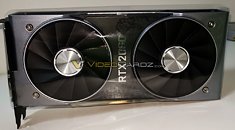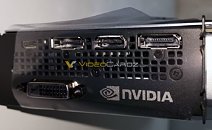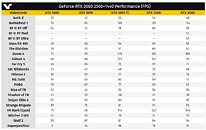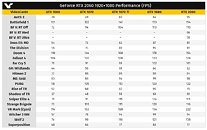Sunday, December 30th 2018

NVIDIA GeForce RTX 2060 Founders Edition Pictured, Tested
Here are some of the first pictures of NVIDIA's upcoming GeForce RTX 2060 Founders Edition graphics card. You'll know from our older report that there could be as many as six variants of the RTX 2060 based on memory size and type. The Founders Edition is based on the top-spec one with 6 GB of GDDR6 memory. The card looks similar in design to the RTX 2070 Founders Edition, which is probably because NVIDIA is reusing the reference-design PCB and cooling solution, minus two of the eight memory chips. The card continues to pull power from a single 8-pin PCIe power connector.
According to VideoCardz, NVIDIA could launch the RTX 2060 on the 15th of January, 2019. It could get an earlier unveiling by CEO Jen-Hsun Huang at NVIDIA's CES 2019 event, slated for January 7th. The top-spec RTX 2060 trim is based on the TU106-300 ASIC, configured with 1,920 CUDA cores, 120 TMUs, 48 ROPs, 240 tensor cores, and 30 RT cores. With an estimated FP32 compute performance of 6.5 TFLOP/s, the card is expected to perform on par with the GTX 1070 Ti from the previous generation in workloads that lack DXR. VideoCardz also posted performance numbers obtained from NVIDIA's Reviewer's Guide, that point to the same possibility.In its Reviewer's Guide document, NVIDIA tested the RTX 2060 Founders Edition on a machine powered by a Core i9-7900X processor and 16 GB of memory. The card was tested at 1920 x 1080 and 2560 x 1440, its target consumer segment. Performance numbers obtained at both resolutions point to the card performing within ±5% of the GTX 1070 Ti (and possibly the RX Vega 56 from the AMD camp). The guide also mentions an SEP pricing of the RTX 2060 6 GB at USD $349.99.
Source:
VideoCardz
According to VideoCardz, NVIDIA could launch the RTX 2060 on the 15th of January, 2019. It could get an earlier unveiling by CEO Jen-Hsun Huang at NVIDIA's CES 2019 event, slated for January 7th. The top-spec RTX 2060 trim is based on the TU106-300 ASIC, configured with 1,920 CUDA cores, 120 TMUs, 48 ROPs, 240 tensor cores, and 30 RT cores. With an estimated FP32 compute performance of 6.5 TFLOP/s, the card is expected to perform on par with the GTX 1070 Ti from the previous generation in workloads that lack DXR. VideoCardz also posted performance numbers obtained from NVIDIA's Reviewer's Guide, that point to the same possibility.In its Reviewer's Guide document, NVIDIA tested the RTX 2060 Founders Edition on a machine powered by a Core i9-7900X processor and 16 GB of memory. The card was tested at 1920 x 1080 and 2560 x 1440, its target consumer segment. Performance numbers obtained at both resolutions point to the card performing within ±5% of the GTX 1070 Ti (and possibly the RX Vega 56 from the AMD camp). The guide also mentions an SEP pricing of the RTX 2060 6 GB at USD $349.99.





234 Comments on NVIDIA GeForce RTX 2060 Founders Edition Pictured, Tested
As for Nvidia's pricing: They will charge as much as they can, which is currently a lot because they have no competition. If AMD or Intel ends up putting out something competitive than maybe we'll see some price drops.
Right and wrong do not apply to capitalism.
Ethical? We can use that - but not right or wrong.
FWIW, I did not upgrade my 1080ti to a 2080ti because for me, it's NOT worth it. But I'm not bitching about it. I'm quietly voting with my wallet but as you'll see, that does nothing to change the situation. Yes - the quaint and rather impotent concept that if I don't buy it, they'll fail... well, there are a lot of people with good incomes that will buy it because to them, it has value.
As for the statement: "are companies dictatorships?" Take a good look at that. Nvidia (NVDA) is a Nasdaq listed company with shareholders that receive dividends for the company's performance. If they started selling cheap cards, the price would tank (that's how it works, it would be seen as a loss of confidence in business product and confidence is what the share index is all about.)
@xkm1948 actually has got it so correct - if you want 'sensibly' priced cards you need a government supported chip maker to swamp the market. Not going to happen. AMD is your only hope of Nvidia prices coming back to earth. And don't hold your breath on that one.
Performance is up and cost is down, and people are still finding a way to complain. Not to mention the lower power draw of this card means lower thermals and fan profile, and just to add icing on the already sweet cake you get some RT cores you'll never use.
Hell, I paid $400 for a GTX 670 years ago when Kepler came out, it didn't have HALF the performance of this card and it sounded LIKE A LAWNMOWER. I don't know if you guys are just now getting into computer hardware but we didn't all have it this easy.
The fact that "right and wrong don't apply to capitalism" sounds like communism with better cars.
No, nvidia responded to market competition.
www.cnet.com/news/nvidia-cuts-prices-on-gtx-260-280-graphics-boards/
No, the problem here is AMD's lack of competition. When this kind of "release the same performance at slightly higher pricing" happened, we'd always have ATI to counterbalance it. Well, ATI or 3dfx. Now, though, AMD's purchase of ATI has left the industry crippled. We're either slaves to Intel's greed or nvidia's greed. That's why there's equal amounts of blame to go toward AMD, whose incompetence is stagnating GPU progress throughout the industry. Hopefully, Intel will come along and price low with decent tech and support with good drivers (far from a sure thing) and give us the competition that AMD seemingly is unable to provide to nvidia.
Everything remained the same. You can still buy a modern 8800 GT type for the same price. So mainstream cards remained with same price, and a normal, mainstream desktop pc still costs 4000kn.
The average MSRP of a flagship nVidia GPU was set at a hair over $525 for nearly a decade, with the majority of new releases being either cheaper or the same price. The GTX 780 was the first card to buck the trend in half a decade, and the GTX 980 looked like a return to that comfortable average before the 10 series and now 20 series have cranked up the heat. Even with the migration of flagship status to 'Ti' series cards the price increase is felt at the launch of the 20 series, with the 2080 Ti's minimum cost set where the first three generations of Titans were.
I have no argument against the fact that performance increased with each generation, except for with the 9800 GTX but that was a very strange special case as the 8800 Ultra was announced after the 9800 series launched, so there's this distinct overlap of product lines that lead to the 9800 GTX taking a bit of a back seat while still being sold as the flagship product of a new generation.
So the actual fact is the 20 series breaks the trend by being the first product series in over a decade to feature an increased MSRP over a previous generation that also had an increased MSRP. It also features the highest increase in average price, as well as the highest MSRP values to date since the 8800 Ultra 11 years ago. Those facts have helped form the opinion of large group of consumers that the entire product series is overpriced.
factsopinions.Research is helpful. Go look up MSRP's from reliable sources and you will find all sorts of useful information. You will also discover that the numbers in his graph are just a bit off.
Here are the prices of older generations that I was able to gather from reviews and retail listings:
Those numbers are largely irrelevant as they show effectively the same general price scale, and have actually decreased the averaged MSRP to $517.Please provide these reliable sources. All you have done thus far is act as the contrarian and provided no tangible proof of your facts. "You are wrong," is not an argument. If you have information to contribute, don't feel as though you need to hold it back. Put it out there, share it, let me be proven wrong! That's the point of the debate.